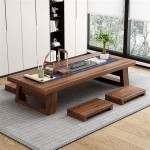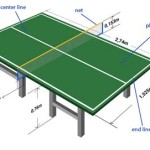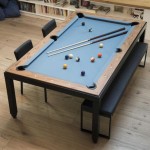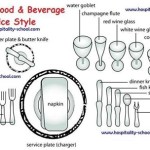Standard 6-Seater Dining Table Size: A Comprehensive Guide
The dining table serves as a central gathering point in many homes, facilitating meals, conversations, and shared experiences. Selecting the right size dining table is crucial to ensure comfortable seating, adequate space for food and serving dishes, and the overall aesthetic harmony of the dining area. The 6-seater dining table is a popular choice, offering a balance between accommodating a moderate number of individuals and fitting within a reasonable footprint. Understanding the standard dimensions and factors that influence the ideal size for a specific space is essential for making an informed purchase.
This article provides a comprehensive guide to the standard size of a 6-seater dining table, exploring various shapes, dimensions, and considerations for selecting the most appropriate table for individual needs and spatial constraints. The information presented aims to equip readers with the knowledge necessary to choose a dining table that optimizes comfort, functionality, and aesthetic appeal.
Understanding Standard Dimensions for 6-Seater Dining Tables
Standard dimensions for 6-seater dining tables vary slightly depending on the shape of the table. The most common shapes are rectangular, oval, square, and round. Each shape offers distinct advantages and disadvantages in terms of seating capacity, space utilization, and overall aesthetic. It is important to note that these are general guidelines, and the actual dimensions may vary slightly depending on the manufacturer and design.
Rectangular Dining Tables: Rectangular dining tables are perhaps the most common and versatile option. A standard rectangular 6-seater dining table typically measures between 60 inches (5 feet) and 72 inches (6 feet) in length and 36 inches to 42 inches in width. This size provides ample space for six individuals to sit comfortably without feeling cramped. The elongated shape allows for easy conversation across the table and offers adequate room for serving dishes.
Oval Dining Tables: Oval dining tables offer a similar seating capacity and functionality to rectangular tables but with a softer, more elegant aesthetic. The rounded edges of an oval table can make it feel less imposing in a smaller space and can facilitate easier movement around the table. Standard oval 6-seater dining tables typically fall within a similar length range as rectangular tables (60-72 inches) and a width of 36-42 inches at the widest point.
Square Dining Tables: Square dining tables are ideal for creating a more intimate and symmetrical dining arrangement. A standard square 6-seater dining table typically measures around 48 inches to 54 inches on each side. This size provides equal seating space for all diners and promotes a sense of equality and connection. However, square tables can sometimes feel less spacious than rectangular or oval tables, especially when accommodating larger serving dishes.
Round Dining Tables: Round dining tables are excellent for fostering conversation and creating a more social atmosphere. The circular shape encourages eye contact and allows all diners to easily interact with each other. A standard round 6-seater dining table typically measures between 48 inches and 60 inches in diameter. While round tables can be space-efficient, particularly in square rooms, they may not be the best choice for rectangular spaces, as they can leave unused corners.
It's essential to consider the height of the dining table as well. The standard height for a dining table is typically between 28 inches and 30 inches. This height provides comfortable legroom for most individuals and allows for easy use of standard dining chairs.
Factors Influencing the Ideal Dining Table Size
While standard dimensions provide a useful starting point, several factors influence the ideal dining table size for a particular space and lifestyle. These factors include the size and shape of the dining room, the number of people who regularly dine at the table, and the desired aesthetic.
Dining Room Size and Shape: The dimensions of the dining room are a primary consideration when selecting a dining table size. It's crucial to ensure that the table fits comfortably within the space without overwhelming it or obstructing movement. A general rule of thumb is to allow at least 36 inches of space between the edge of the table and any walls or furniture. This clearance allows for comfortable chair movement and passage around the table.
For smaller dining rooms, a smaller 6-seater table or even a 4-seater table that can be extended to accommodate six people may be a more practical choice. In larger dining rooms, a larger table can fill the space more effectively and create a more formal and inviting atmosphere. The shape of the room also influences the choice of table shape. Rectangular tables tend to work well in rectangular rooms, while round or square tables can be more suitable for square rooms.
Seating Capacity and Usage: The number of people who regularly dine at the table is another important factor to consider. If the table is primarily used for everyday meals by a smaller household, a smaller table may suffice. However, if the table is frequently used for hosting guests or family gatherings, a larger table with expandable leaves or extensions may be necessary. Even if the table is technically a "6-seater," consider whether you need additional space for serving dishes or elbows when all seats are occupied. Overestimating seating needs is generally preferable to underestimating, ensuring that everyone has enough room to dine comfortably.
Aesthetic Preferences and Style: The desired aesthetic and style of the dining room can also influence the choice of dining table size and shape. A minimalist or modern dining room may benefit from a sleek and understated table, while a more traditional or formal dining room may call for a larger, more elaborate table. The material, finish, and design of the table should complement the overall style of the room and reflect the homeowner's personal taste. Consider the visual weight of the table; a dark, heavy table might feel more imposing in a small room than a light-colored, airy design.
Practical Considerations for Choosing a 6-Seater Dining Table
Beyond the standard dimensions and influencing factors, several practical considerations can help ensure that the chosen 6-seater dining table meets individual needs and preferences. These considerations include the type of table base, the material of the tabletop, and the ease of maintenance.
Table Base: The type of table base can significantly impact the stability, legroom, and overall aesthetic of the dining table. Common table base options include four legs, a pedestal base, and a trestle base. Four-legged tables are generally the most stable and offer ample legroom, but the legs can sometimes get in the way of chairs or make it difficult to scoot closer to the table. Pedestal bases provide more legroom and a cleaner look, but they may be less stable than four-legged tables, especially with larger tabletops. Trestle bases offer a rustic and unique aesthetic, but they can sometimes limit seating options and legroom. When assessing legroom, consider the placement of the table legs in relation to chair placement. A table with legs set closer to the corners will provide more legroom than a table with legs positioned further inward.
Tabletop Material: The material of the tabletop affects the durability, maintenance, and aesthetic of the dining table. Common tabletop materials include wood, glass, stone, and metal. Wood is a classic and versatile choice, offering warmth and character, but it requires regular maintenance to prevent scratches and stains. Glass tabletops are easy to clean and create a modern and airy look, but they can be prone to fingerprints and scratches. Stone tabletops, such as marble or granite, are durable and elegant, but they are also heavy and expensive. Metal tabletops are durable and industrial-chic but can be cold and prone to dents and scratches. Consider the level of maintenance you are willing to undertake. Wood tables, for example, may require regular polishing to maintain their luster, while glass tables need frequent wiping to remove fingerprints.
Ease of Maintenance: The ease of maintenance is an important consideration, especially for busy households. Some materials, such as glass and metal, are relatively easy to clean and maintain, while others, such as wood and stone, may require more specialized care. It's essential to choose a tabletop material that suits the lifestyle and cleaning habits of the household. Also, consider the finish on the tabletop. A durable finish, such as polyurethane, can protect the tabletop from scratches and stains and make it easier to clean. A matte finish can hide smudges and fingerprints better than a high-gloss finish. Before purchasing, inquire about the recommended cleaning products and procedures for the specific tabletop material.

6 Seater Dining Table Dimensions Furdir Tavolo Tondo In Resina Arredamento

Explore The Versatility Of Rectangle Tables For Dining
What Size Dining Table Seats 6 Quora
What Size Dining Table Seats 6 Quora

What Is The Standard Size Of A 6 Seater Dining Table Fabuliv Blogs 2024

Creative 8 Person Dining Table Size For Your Eoyment Sizes Diy Room

Buy Terrene 6 Seater Dining Table Set In Beige At Upto 70 Discount Godrej Interio

Odra Solid Wood Six Seater Dining Set Tables Fabuliv

Pin By Oana Tiution On Dinning Room Dining Table Sizes 12 Person 6 Seater

How To Calculate The Best Dining Table Size For Your Room








